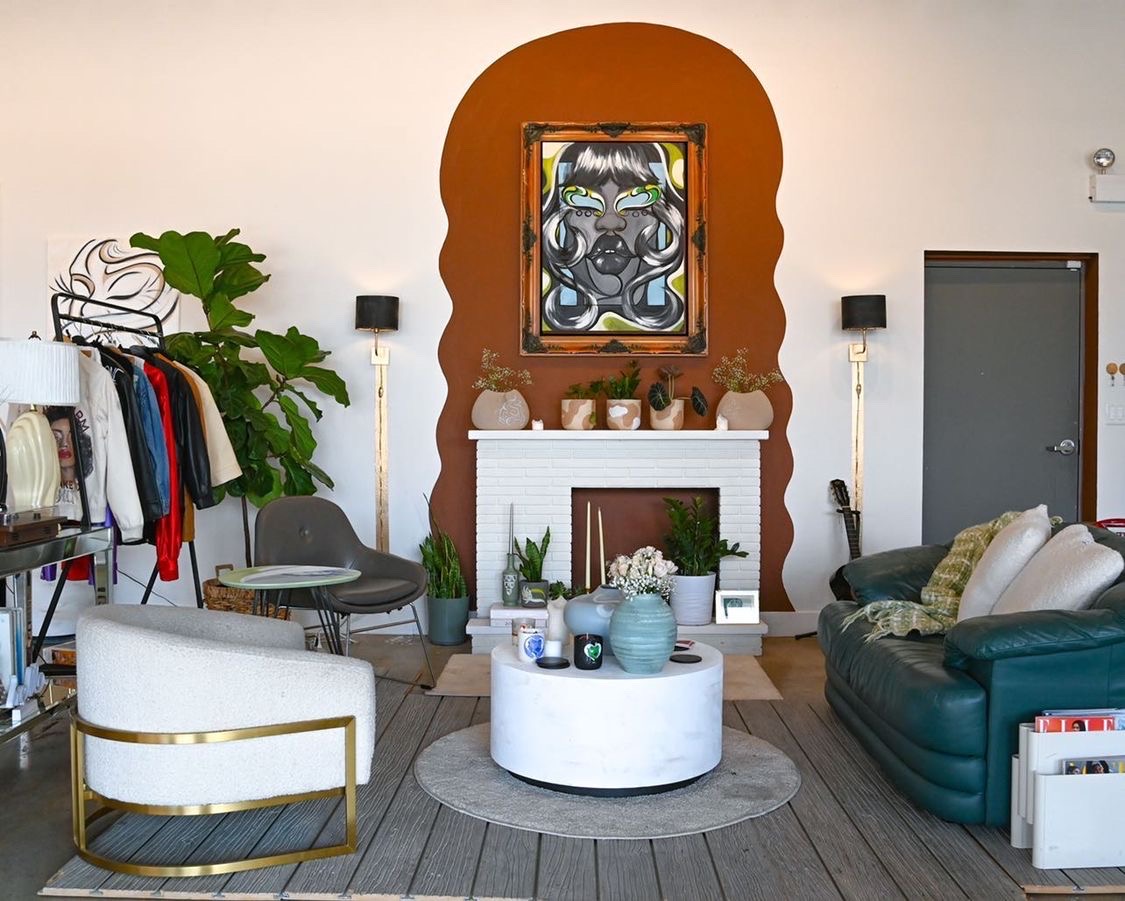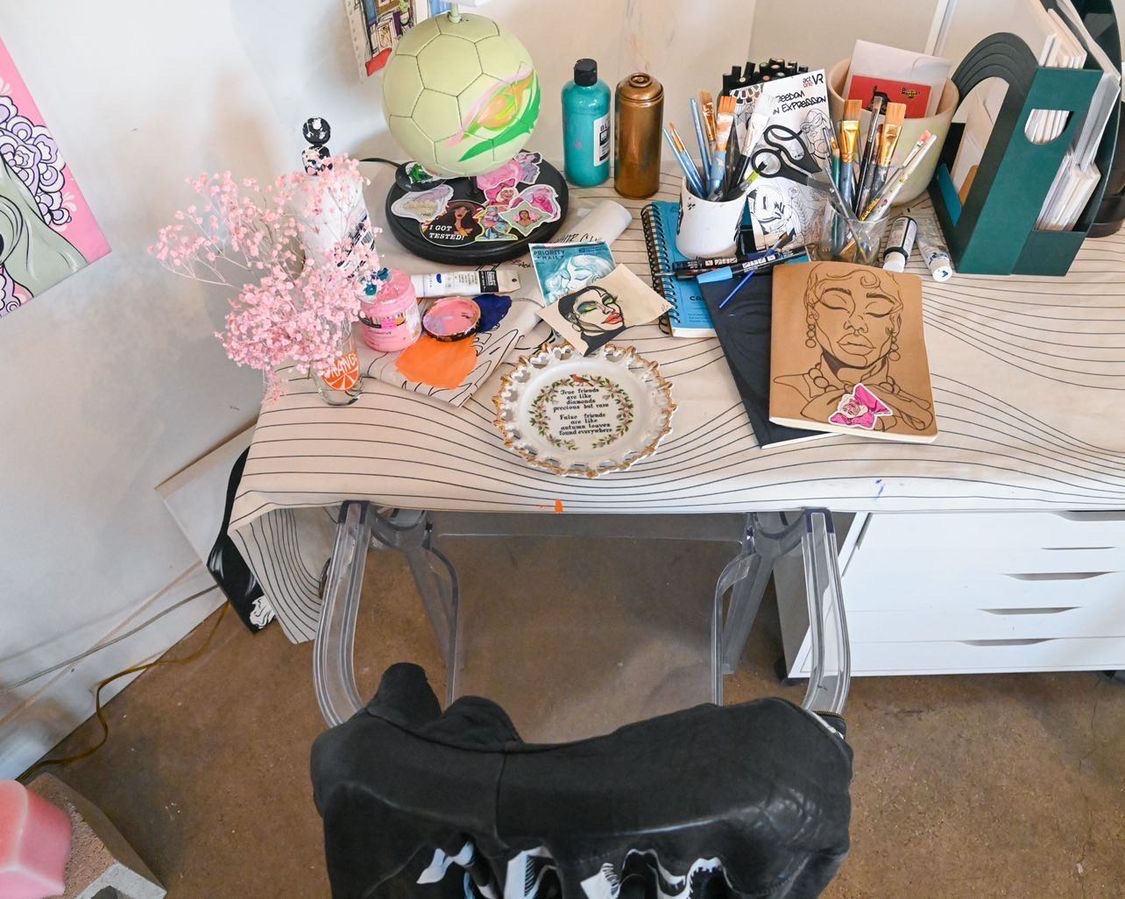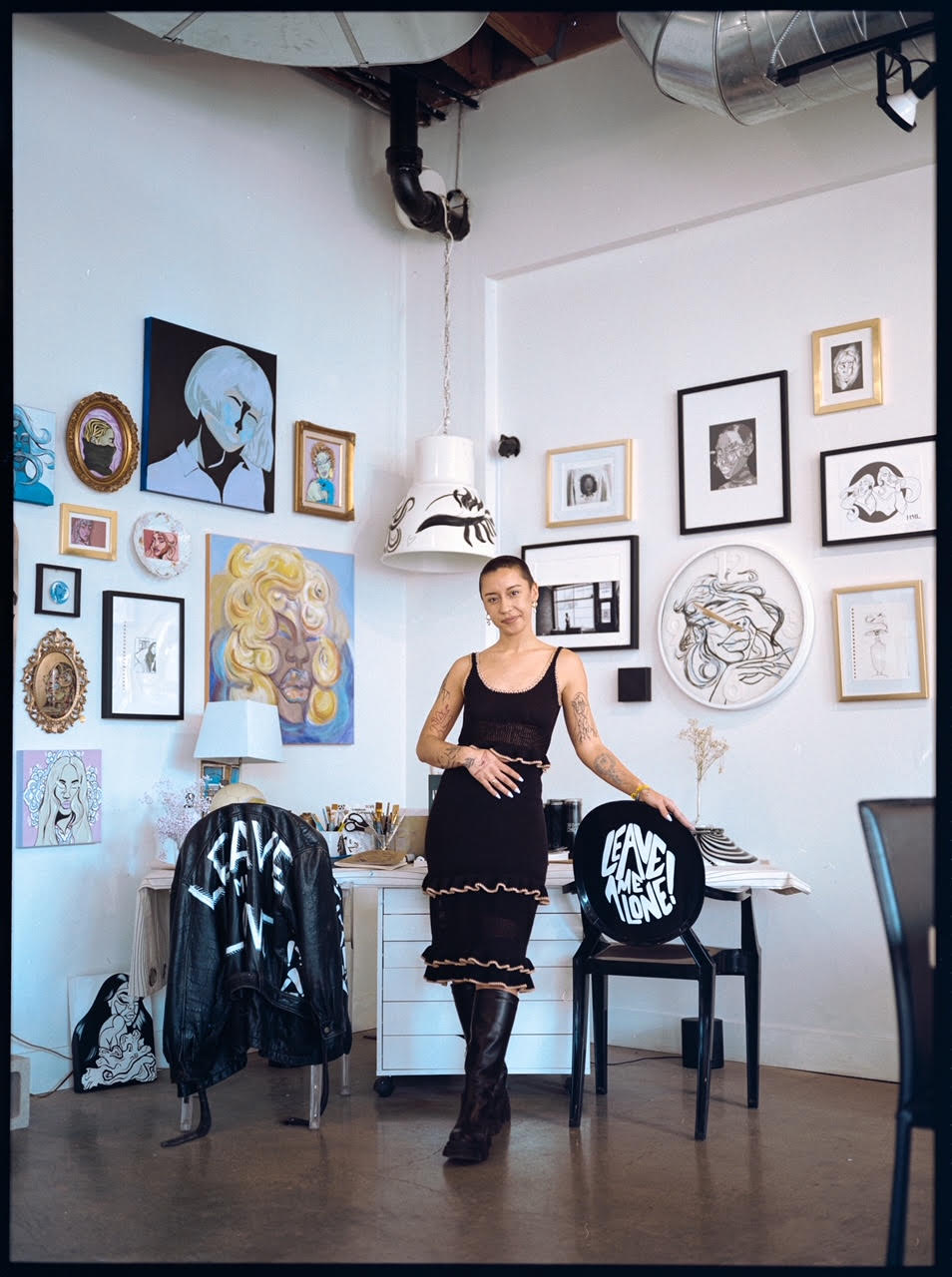Hailey Marie Losselyong is a self-taught and multi-disciplinary visual artist based in Pilsen. She works under the name HML Art & Design, creating bold murals, illustrations, and clothing designs with abstract female portraits.
Her latest installation, HML Home, is housed at Vault Gallerie in Pilsen until May 7. Turning a gallery space into an IKEA-style apartment, Losselyong furnished it with pieces from her past work—wall art, furniture, and clothing—to celebrate her creative evolution as an artist and what it means to create intentional accessible art.


While walking through it, you get the impression of sneaking about a friend’s apartment as they go to the bathroom for a moment. Immediately, you start nosing through a free-standing closet rack and poking through the brightly-colored stickers and prints on their desk. The more you look around, the more you notice stylized, unbothered women, painted with colored lips and their eyes closed. Some have the slogan “Leave Me Alone” stenciled into their earrings or by their sides, as if saying, “Leave me alone. Do no harm, but take no shit!”
You see it patterned on the backs of jackets, on the shoes tucked under the mirror, and in the framed images on the walls. It’s painted on the flower pots, on the coffee table, and on the drink coasters. When it’s your turn in the bathroom, the women are there again, towering over you on the wall. What are they thinking about when they close their eyes?
South Side Weekly spoke with Losselyong about her creative process and the inspiration behind her Leave Me Alone art series, which was inspired by unsolicited interactions from men that women often face in public. This interview has been edited for length and clarity.
How do you describe yourself as an artist?
I say I’m a multi-disciplinary visual artist. I’ve focused mainly on painting in the past, so painting on pretty much anything, like canvas, walls, clothes—anything. I also like visual arts in general. I like to take photos and do video content and things like that, too. But I think my artwork centers around portraits of people. My paintings are portraits that highlight femininity and the duality of femininity and different strengths versus weaknesses within femininity.
When did you first start doing visual art?
I didn’t start painting my own original paintings until I went to college. In 2014, I went to school for business, but then I ended up taking a couple of Illustrator workshops. I was doing a little bit of painting to make some money on the side, just commissions of anything, really. After a year or two of that, I fell into my own style.
How do you describe your art style?
I want it to be impactful when you see it. I want people to recognize that it’s mine, but also feel something. I like making things really big or bold, [though] now I’m focusing on a little bit more movement. Just making you feel something when you look at it.
Where do you get inspiration from when you start a new project? What does your creative process look like?
It’s collaborative in a way. People see what type of artwork that I make, but then we come together, and I see what their style is, what their vibe is, and we have a happy medium.
It’s definitely very inspired by women and femininity. I like showing women and women of color. A lot of my bigger projects started by being able to put murals in spaces where they weren’t before and put murals of women of color in spaces where they hadn’t been seen before. I feel like that’s just really important for me to help people that need to see themselves in artwork. I think it’s really important that everybody feels represented, especially through art.
What inspired your Leave Me Alone artwork?
It started from street harassment. A few years back, I had some pants that I had drawn some girls on and I had also written “Leave Me Alone” small on the front. And I was like, I just want to see what happens. It was a summer night, and I had to wait for a couple of friends by myself, and I ended up being followed into a 7-Eleven by a group of people. Thankfully, nothing happened. But it was just like, I can literally write it on me to leave me alone, that I’m not asking for anybody’s attention, and still, my boundaries are being crossed, and my safety is being questioned. I’m made to feel uncomfortable for no reason.
So after that, I started drawing it and writing it really big on a lot of my clothes. And other girls were supporting that. I got a lot of questions from men, too. But most of them were just curious about what it meant, and when I explained it to them, they were like “Oh, that’s not something that I’ve ever thought about.” So it’s like a little think piece. It’s not like, “Don’t talk to me or approach me.” [But] think about the way that you’re going to approach me before you do it.
How long have you been working with this series?
I started that in the summer of 2017 or 2018, and it’s grown from there. From my experience, it [began with] literal street harassment. But like with the rest of my work, I really like to leave it open to interpretation for whoever is digesting it, because it can mean different things for different people. And I think [the message is], in general, for people: just respect one another. Think about your actions and the things that you’re saying or the things that you’re doing and how it might seem like a small action to you, but it can really affect other people.
What’s so interesting about working in so many different mediums?
I just really don’t believe in having to do one singular thing. There are so many ways to express yourself creatively. Why only focus on one medium? And I give people their props when they do focus on one thing, that’s awesome, and you’re probably a pro, but just the way that my personality is, I like to experiment and bounce around a little bit and figure new things out. I like to be challenged. It’s just fun that way. I think I picked a freelance career in order to be able to dictate what type of projects I want to work on, and that’s a really important part to me—to be able to have room for creative growth.
What’s been your favorite project to work on?
My favorite project has probably been working with the Mural Movement. The Mural Movement was run by Delilah Martinez. She’s also the owner of Vault Gallerie, where I’m hosting the show at right now, but the Mural Movement was born in 2020, during protesting, when our neighborhood was all boarded up, so people started offering to do murals on storefronts to make it seem like a little less of a war zone and bring us back to some sense of normalcy. And they were all in support of Black Lives Matter [and] Black and brown unity. Through the Mural Movement, almost 200 murals have been done, but it’s allowed myself and other artists to just get an opportunity to paint big projects or even travel to work.
And for artists, having opportunities to be able to show your work is just as important. Not everybody can just find a big thirty-foot wall that somebody’s going to allow them to paint on for the first time without [first] seeing their work, but we’ve been able to give different artists opportunities to showcase their talents, and then get bigger and better jobs after that. I think working with them has been cool, because most of the murals are going to Black or brown businesses or in Black or brown communities or small businesses that wouldn’t normally be able to afford a large mural.
Why do you think it’s important to use art for social justice?
It’s just important for young people to see themselves in a positive light. When we’re doing these mural projects or projects in different communities, it always draws positive attention from the people that live in the area. They want to come and hang out and help paint. There is no lack of need for art or attention in these areas. People clearly are embracing it and want it to happen. But there’s not enough emphasis being put on beautifying spaces. I think how a space that you live in looks is important. It’s important for your neighborhood to have colors and art and every neighborhood treated the same because people just want to see themselves represented in their own neighborhoods. Nobody wants more blank walls and boarded-up windows.
Why did you design your installation at Vault Gallerie in the way that you did?
It’s definitely inspired by IKEA. So IKEA is one of my favorite places to visit. It’s like a Sunday trip type of thing. But I’ve always been curious about making art. I’m really supportive of affordable art. I think that art can be an intimidating space for people to enter. I like being accessible in that way and having interest in furniture and design and exploring those avenues. I just love the idea of IKEA, like IKEA sets everything up for you. They show you exactly how it could be used, and people can just truly envision purchasing a product because they can envision it in their space and envision it in their home. I just think the home is such an important space, and it should really reflect you and your personality. And also, there can be more items in your home that are functional but still have art on them. Any item can be considered art. It doesn’t have to be just canvas or framed pictures. There can be anything.
How long have you been working on the installation?
There’s an accumulation of work over the last few years. I’d say about fifty percent of the paintings and things have been done within the last year, but all of the furniture and bigger pieces and walls and stuff were done within the last two weeks. So I’ve been working on it for a little while in my brain, but physically, just the last few weeks.
How has Vault Gallerie been a source of support for you?
I’ve been working with Vault Gallerie since it started. Before we even had this location, we were back on a different side of Pilsen. I used to be a paint and sip instructor and candlemaking instructor with Delilah, we would do these classes together. Then she opened up the gallery and started giving more spaces to show work, and I was transitioning more and more into my freelance art career. She’s been 100% a source of help in every single area. Honestly, she’s given me space to show my work in the gallery and do this whole crazy installation. She doesn’t really put any limitations on artists in her space, which is great. And then running the Mural Movement and stuff, she gives a lot of different artists the opportunity to show their work and sell their work and be seen. She’s really important in the city.
What would you tell someone getting into art for the first time? What would you tell a younger version of yourself?
I would tell myself to experiment earlier. Learn from more people. [That going] out of my way to really shadow people and interning for people can be a good thing. Even if it’s not exactly what you want to do, if it’s in the ballpark, it’s just good to watch somebody be a professional and learn the business side of things. Because if you want to be a full-time artist, it doesn’t matter how great you paint, you’ve still got to figure out the business side.
But ultimately, just try whatever you want—try it, fail, and move on. Because there are plenty of projects where I feel like I haven’t executed exactly the way that I wanted to, but you learn and you move on, and you do better the next time. It’s better than not doing it at all.
What are you most proud of with your work?
I think just the little community that it’s created because there’s so many different items out there in the world. Now whether it’s bags or jackets or canvas or tattoos, it’s just really cool to see people and friends in different states sending me or somebody with a tattoo of mine.
Are there new things to expect from you?
I feel like there are always new things to expect. I don’t really plan too far ahead, and I go with the flow. But I’m definitely looking forward to doing more installations, more spaces, and doing more collaborative pieces and working with new people and companies. And just making everything bigger and better.
Reema Saleh is a journalist and graduate student at University of Chicago studying public policy. She can be followed on Twitter at @reemasabrina. She last wrote about Blue Tin Production and their vision for a studio and community center in Chicago Lawn.


